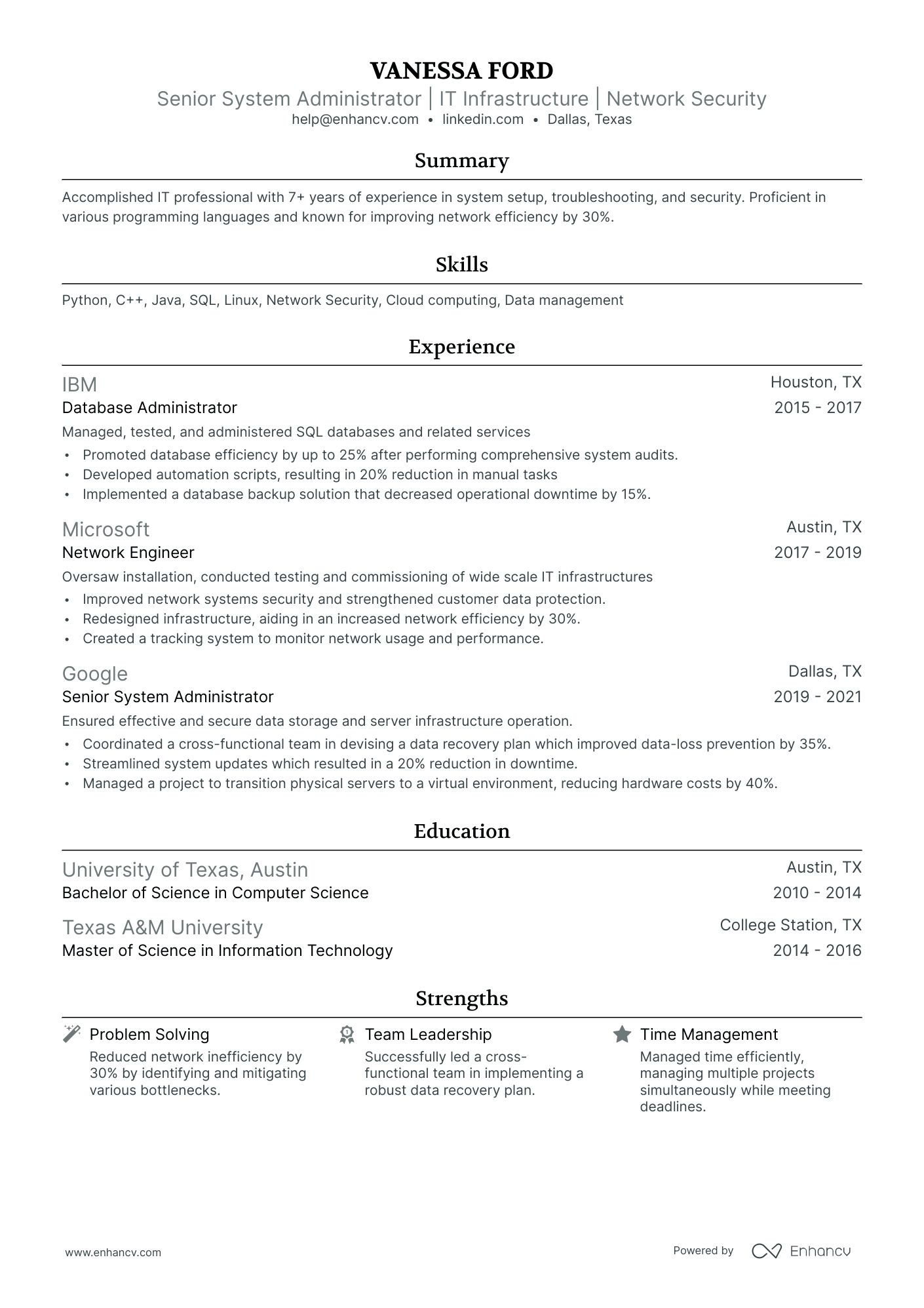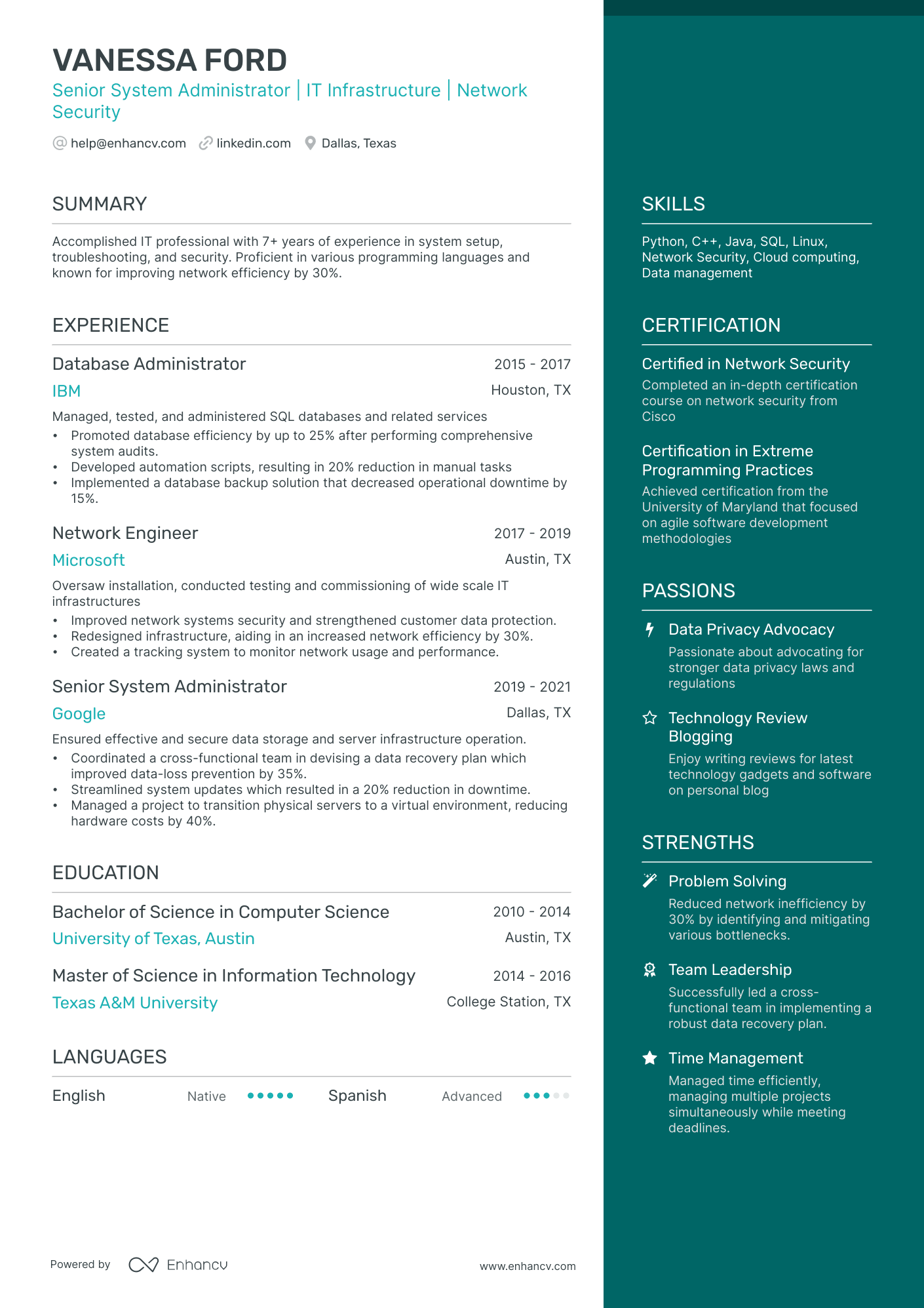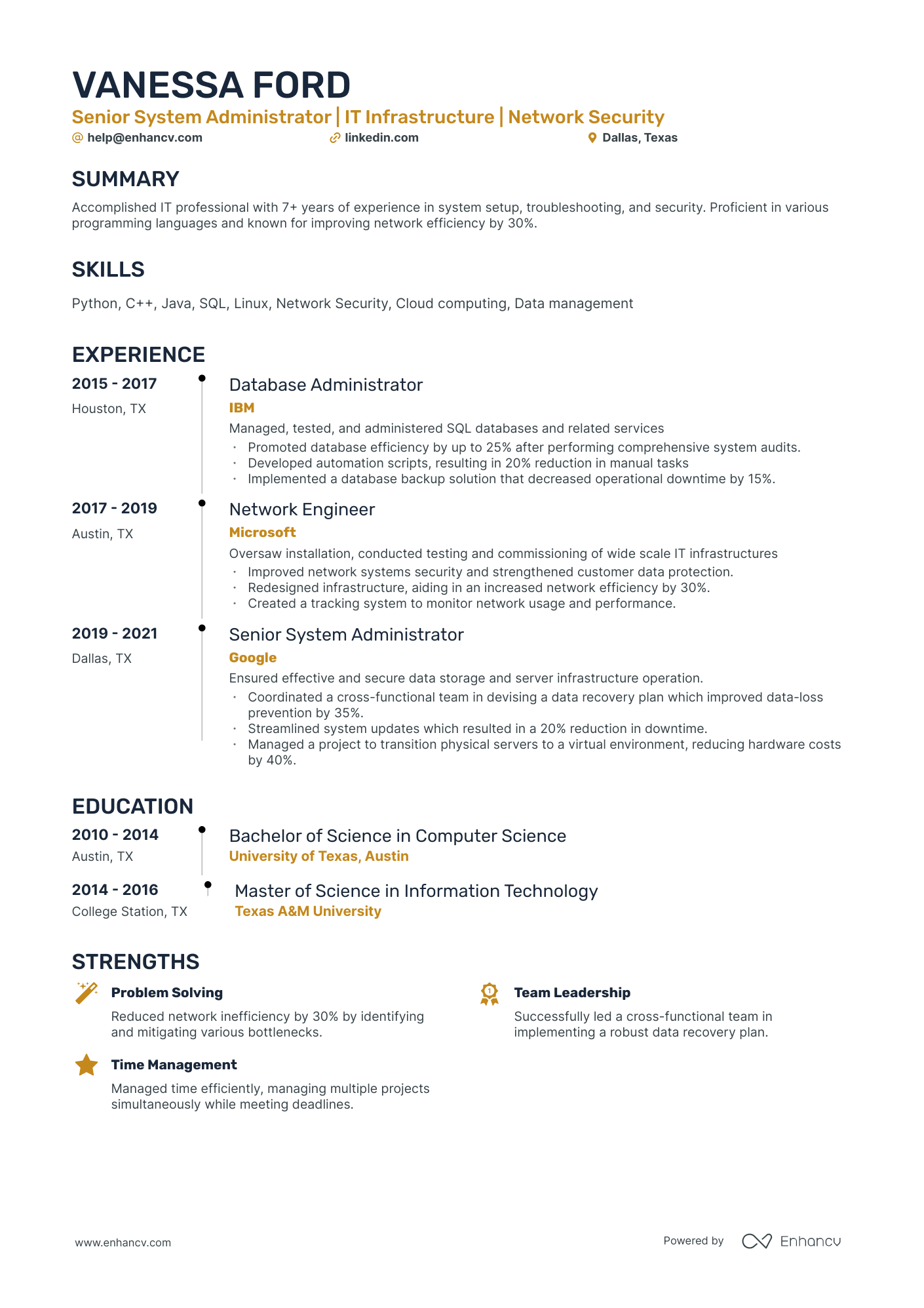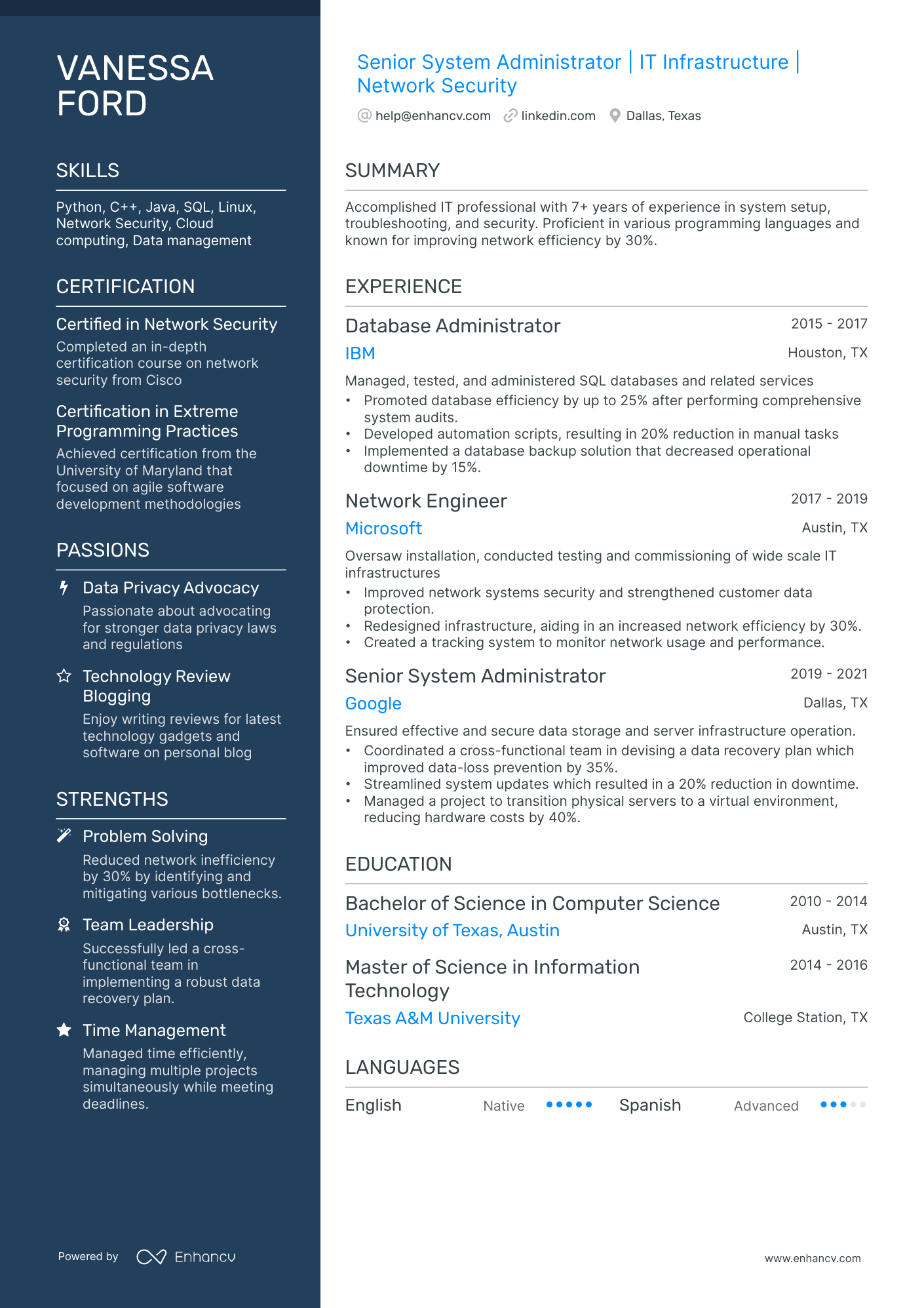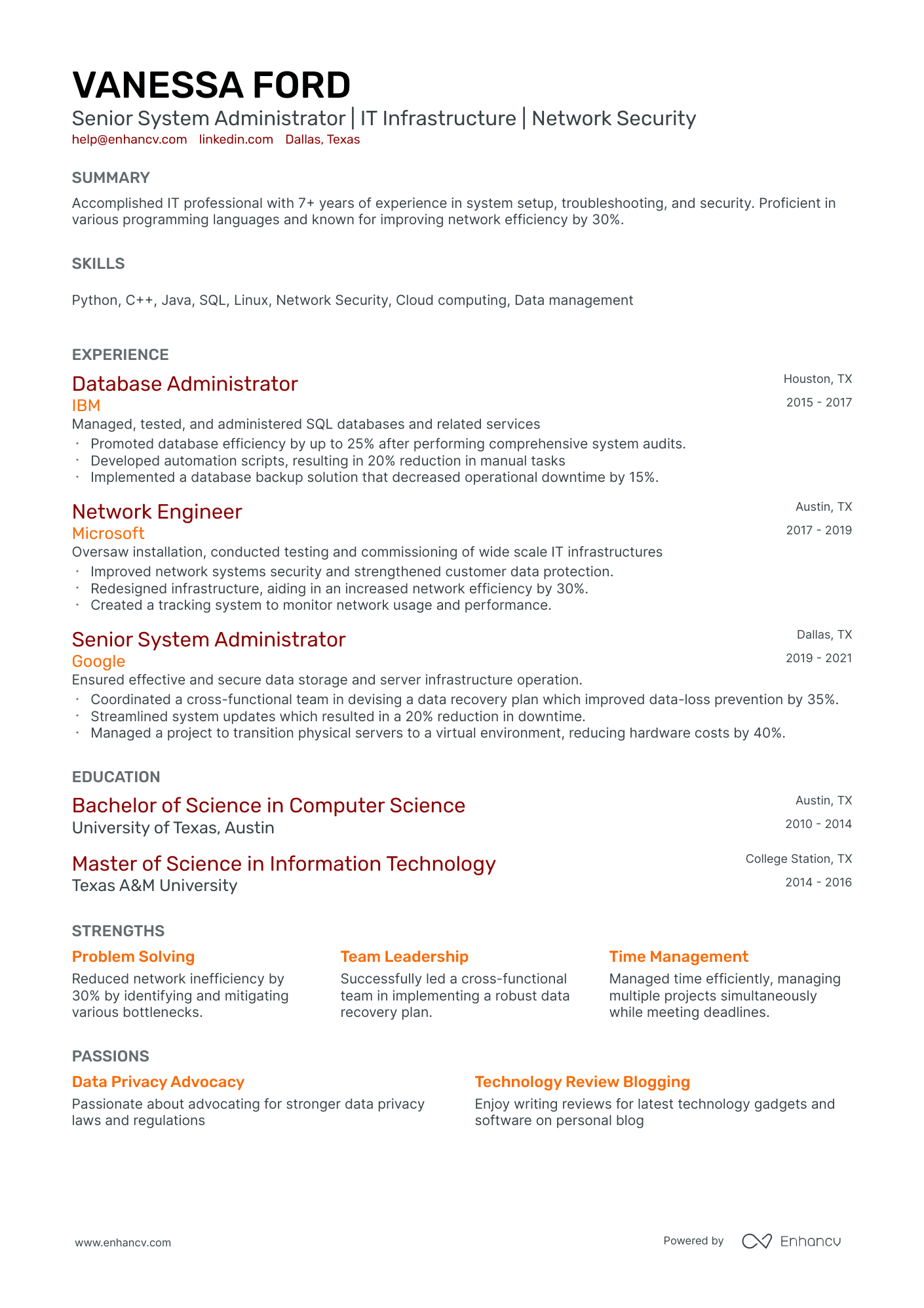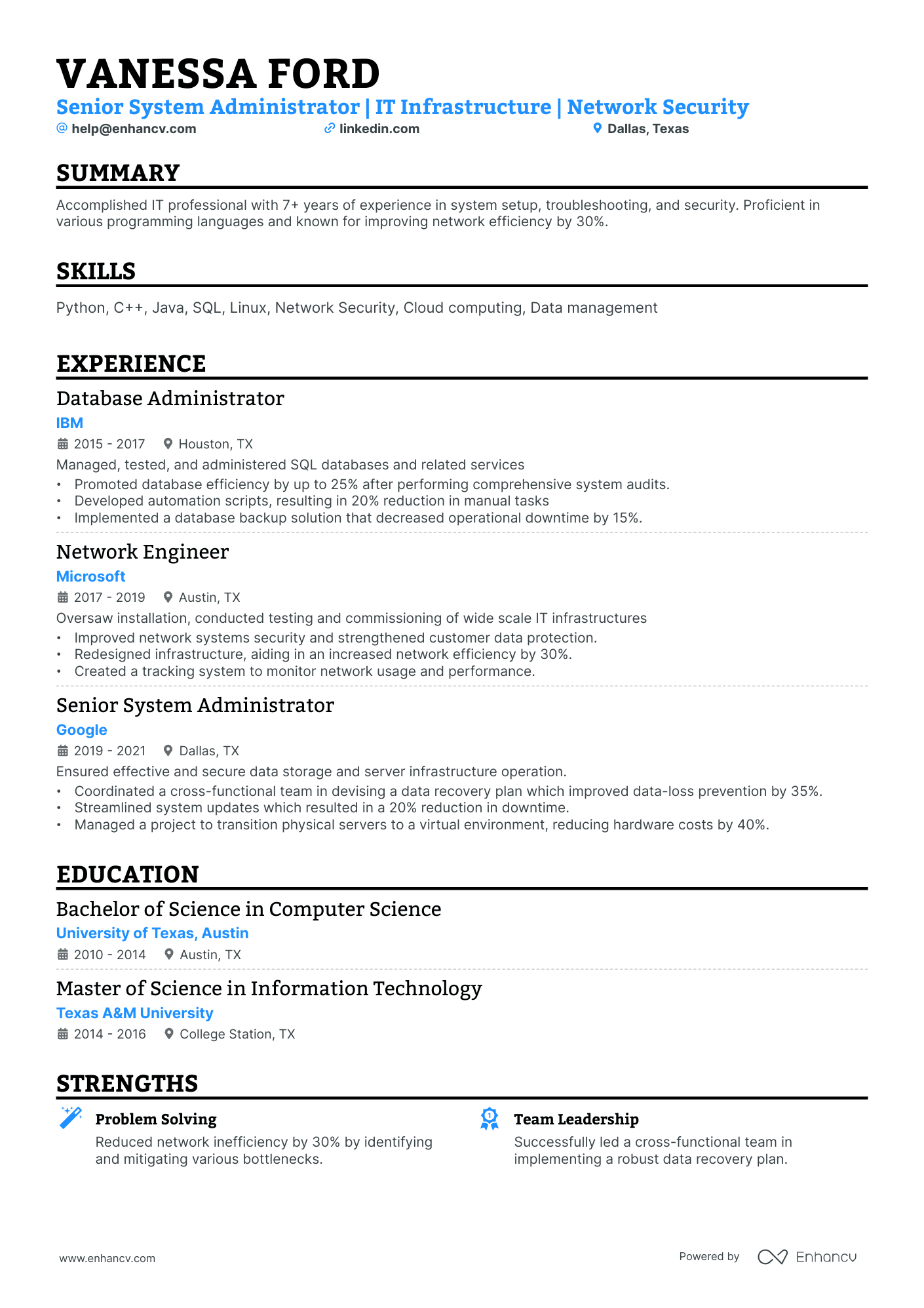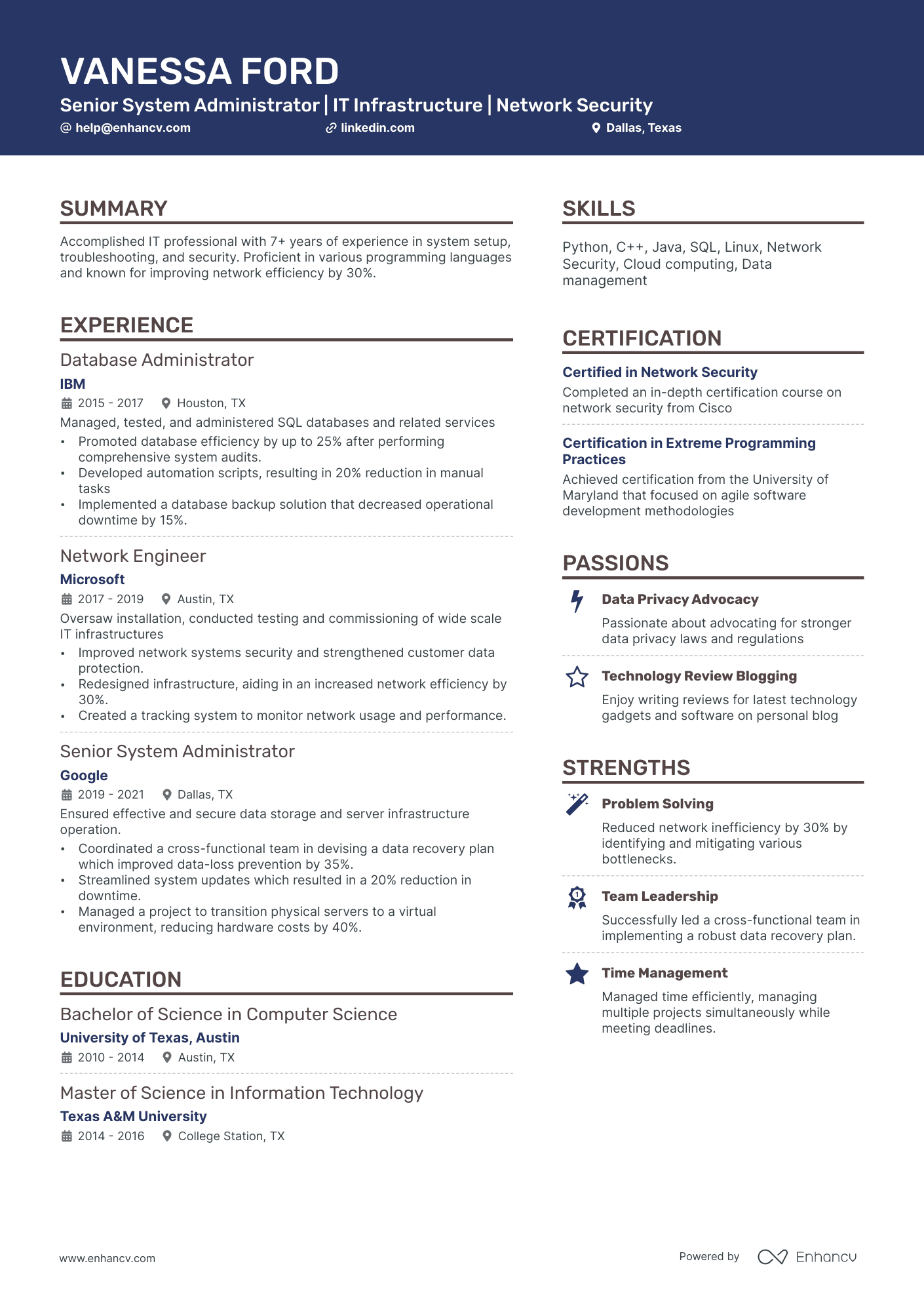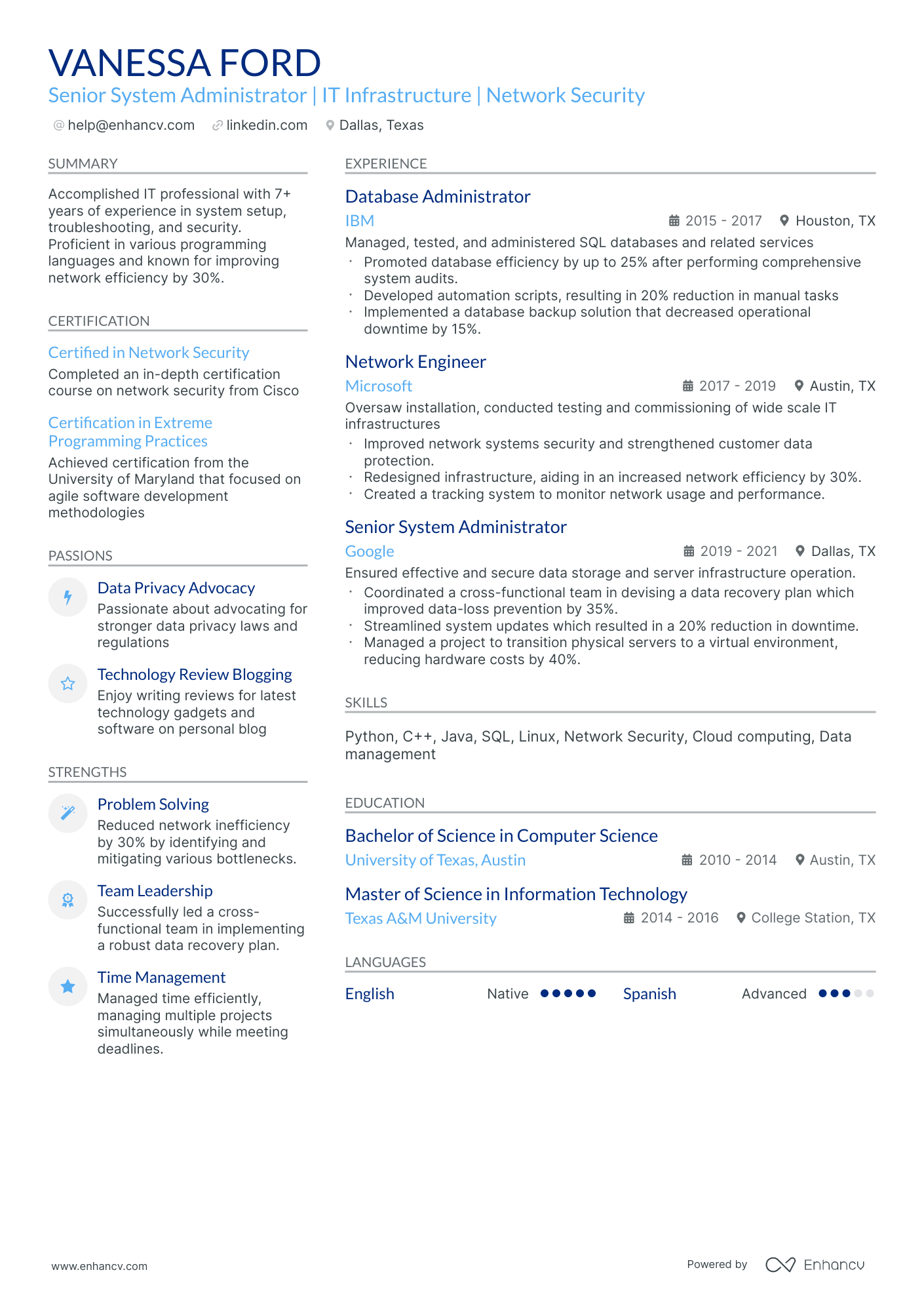A significant challenge faced by senior system administrators is articulating their technical competencies and experiences in a way that non-technical recruiters can understand. Our guide provides strategies for translating complex IT tasks into accessible language, ensuring that your skills and achievements are effectively communicated to all potential employers.
Dive into this guide to discover how to craft a compelling senior system administrator resume:
- Explore top-tier senior system administrator resume samples, spotlighting industry-leading skills and experiences.
- Uncover over ten tailored strategies to make your senior system administrator resume resonate with the job description.
- Illuminate your unique value as a senior system administrator candidate, using your professional achievements as a guide.
- Debunk the myth that education doesn't matter, and learn how to leverage your academic and certification credentials effectively.
Recommended reads:
simple guide to your senior system administrator resume format
Successful senior system administrator resumes all have something in common - candidates invest in a simple resume layout . One that is easy to read, makes a good first impression, and is adapted to their professional experience.
There are three distinct resume formats , which help you focus on different aspects of your resume. Those are:
- A reverse-chronological resume format - puts your most recent experience in the spotlight
- A functional skill-based resume format that makes your transferrable skills the center of attention
- A hybrid resume format - it combines skills and experiences.
What's more, keep in mind that your resume usually goes through an ATS (Applicant Tracker System) (i.e. the software used by companies in the hiring process).
The senior system administrator resumes that suit the ATS:
- incorporate exact match keywords and skills from the job description;
- should be no longer than two pages;
- should be submitted in a PDF format, unless specified otherwise.
Tailor your resume format to the job market – a Canadian resume, for example, might differ in layout.
Upload your resume
Drop your resume here or choose a file. PDF & DOCX only. Max 2MB file size.
Pro tip
Choose a legible, professional font for your senior system administrator resume, such as Arial or Calibri.
Key sections to include in your senior system administrator resume are:
- The header - with your contact details (like email and phone number), a link to your portfolio, and a headline.
- The summary (or objective) - highlighting the high points of your career so far.
- The experience section - limit yourself to six bullets per role to focus on specific results.
- The skills list - offering a balanced mix of your personal and professional talents.
- Education and certification - displaying your most relevant degrees and certificates for the senior system administrator role.
What recruiters want to see on your resume:
- Experience with managing and maintaining servers, databases, networks, and other system infrastructure.
- Proficiency in using various system administration tools and software, such as Windows Server, Linux, VMware, Active Directory, etc.
- Demonstrable ability to design, test, and implement system-level security measures including firewalls, intrusion detection systems, anti-virus software, etc.
- Knowledge of cloud computing platforms (Azure, AWS) and virtualization technology.
- Certifications like MCSA (Microsoft Certified: Systems Administrator), RHCE (Red Hat Certified Engineer), or CCNA (Cisco Certified Network Associate), which validate relevant technical skills.
Recommended reads:
How to create the cornerstone experience section of your senior system administrator resume
A meticulously crafted senior system administrator resume experience section is a recruiter's delight. This segment not only responds to job criteria but also throws light on your technical expertise and character.
To craft an impactful experience section:
- Highlight roles directly related to the position in question.
- Pair each role or task with a metric that quantifies your achievements.
- Chronicle your senior system administrator career progression, illustrating your dedication and growth in the domain.
- For each role, elucidate challenges faced, strategies employed, and the broader organizational impact.
Examine the following senior system administrator samples to discern how seasoned professionals have articulated their experiences:
- Managed and maintained a complex server infrastructure comprising over 200 virtual machines, resulting in improved system stability and reduced downtime by 30%.
- Implemented a comprehensive backup and disaster recovery strategy, ensuring data integrity and minimizing the risk of data loss.
- Collaborated with cross-functional teams to plan and execute server migration projects, successfully transitioning critical applications to new hardware and software platforms.
- Developed and implemented security policies and procedures, resulting in enhanced network security and compliance with industry regulations.
- Provided technical support and troubleshooting for server-related issues, resolving incidents within established SLAs and minimizing impact on business operations.
- Optimized server performance through proactive monitoring and regular maintenance, resulting in a 20% improvement in system response time.
- Led the implementation of a centralized authentication system, streamlining user management and improving access control across the organization.
- Planned and executed a server consolidation project, reducing physical server count by 40% and achieving cost savings of $100,000 annually.
- Researched and evaluated new technologies and solutions, recommending and implementing upgrades that improved system efficiency and scalability.
- Provided training and technical guidance to junior system administrators, fostering their professional development and enhancing team productivity.
- Administered and maintained a heterogeneous server environment, including Windows and Linux servers, ensuring high availability and optimal performance.
- Upgraded and migrated critical applications to new platforms, minimizing service disruptions and enhancing system functionality.
- Implemented automated server monitoring and alerting system, reducing response time to critical incidents by 50%.
- Collaborated with network engineers to design and implement secure remote access solutions, facilitating efficient and secure remote administration.
- Developed and documented standard operating procedures (SOPs) for system administration tasks, improving operational efficiency and knowledge sharing.
- Managed Active Directory services, including user provisioning, group policy management, and domain controller maintenance.
- Performed regular system audits and vulnerability assessments, implementing security patches and updates to mitigate potential risks.
- Provided on-call support for system emergencies, resolving critical issues promptly and minimizing service disruptions.
- Collaborated with software developers to deploy new applications, ensuring compatibility and optimal performance in the production environment.
- Assisted in the planning and execution of disaster recovery drills, validating the effectiveness of backup and restore procedures.
- Managed and optimized virtualization infrastructure with VMware vSphere, resulting in improved resource utilization and reduced hardware costs.
- Designed and implemented a centralized logging and monitoring solution using ELK Stack, enabling proactive identification and resolution of system issues.
- Led the migration of legacy physical servers to a private cloud environment, improving scalability and reducing operational costs by 25%.
- Collaborated with network architects to design and implement a secure network segmentation strategy, enhancing data protection and preventing unauthorized access.
- Developed and maintained comprehensive documentation for system configurations, standard operating procedures, and troubleshooting guides.
- Managed Microsoft Exchange Server environment, including mailbox administration, email routing, and anti-spam measures.
- Implemented a patch management system, ensuring timely installation of security updates and minimizing vulnerabilities.
- Designed and implemented a high-availability storage solution using SAN technology, resulting in improved data availability and reduced downtime.
- Supported database administrators in performance tuning and optimization efforts, enhancing the responsiveness of critical database systems.
- Participated in incident response activities, investigating and resolving system outages and security breaches.
- Administered and maintained Windows server infrastructure, including Active Directory, DNS, DHCP, and file/print services.
- Provided end-user support, troubleshooting hardware and software issues and resolving them within established SLAs.
- Assisted in the planning and execution of server upgrades and hardware refresh initiatives, ensuring minimal disruptions to business operations.
- Implemented server virtualization using Hyper-V technology, consolidating server resources and reducing power consumption.
- Collaborated with cross-functional teams to develop and implement disaster recovery plans, ensuring business continuity in case of system failures.
- Managed and maintained a hybrid cloud infrastructure, integrating on-premises servers with public cloud services for optimal scalability and cost efficiency.
- Developed and implemented security hardening measures, including firewall configurations and intrusion detection systems, ensuring protection against cyber threats.
- Led the implementation of configuration management tools such as Ansible, improving system deployment speed and reducing human errors.
- Implemented a centralized monitoring and alerting system using Nagios, enabling proactive identification and resolution of system issues.
- Collaborated with DevOps teams to automate system administration tasks, resulting in improved operational efficiency and faster application deployments.
- Administered and supported VMware ESXi server environment, managing virtual machine provisioning, resource allocation, and performance monitoring.
- Implemented data backup and disaster recovery solutions, ensuring business-critical systems could be quickly restored in case of failures.
- Provided technical expertise and guidance to junior system administrators, fostering their professional growth and enhancing team collaboration.
- Evaluated and recommended hardware and software upgrades to improve system performance and meet evolving business needs.
- Implemented network access control policies, enforcing security standards and mitigating the risk of unauthorized access.
- Managed Linux server infrastructure, including distribution selection, installation, configuration, and maintenance.
- Implemented a centralized configuration management system using Puppet, enabling efficient administration and maintaining consistency across servers.
- Designed and implemented a scalable storage solution using Ceph, improving data availability and performance for distributed applications.
- Collaborated with software development teams to deploy web applications in production environments, ensuring optimal performance and stability.
- Provided on-call support for critical incidents, quickly identifying and resolving system issues to minimize downtime.
Quantifying impact on your resume
<ul>
Addressing a lack of relevant senior system administrator experience
Even if you lack direct senior system administrator experience, you can still craft a compelling resume. Here's how:
- Highlight projects or publications that demonstrate your relevant skills or knowledge.
- Emphasize transferable skills, showcasing your adaptability and eagerness to learn.
- In your objective, outline your career aspirations and how they align with the company's goals.
- Consider a functional or hybrid resume format, focusing on skills over chronological experience.
Recommended reads:
Pro tip
Boost your resume by focusing on the practical aspects of each job requirement. While it's good to have job-related keywords on your resume, ensure they're backed by action verbs and quantifiable data. This gives recruiters a clear picture of your senior system administrator professional journey.
Essential senior system administrator hard and soft skills for your resume
Recruiters evaluate not just your professional history, but also how your skills resonate with the job's requirements.
Your skills are categorized into:
- Hard or technical skills: These reflect your proficiency in specific tasks or technologies.
- Soft skills: These pertain to your interpersonal abilities and how you adapt to various situations.
When crafting your resume, ensure you:
- Highlight five to six skills that directly align with the job description.
- Integrate industry-specific keywords while also emphasizing your unique strengths.
- Support your skills with an achievements section, detailing tangible outcomes.
- Quantify your proficiency wherever possible, rather than merely listing skills.
To help you, we've curated a list of the most sought-after hard and soft skills for senior system administrator roles.
Top skills for your senior system administrator resume:
Linux Administration
Windows Server Management
Virtualization (VMware, Hyper-V)
Cloud Services (AWS, Azure, Google Cloud)
Networking (TCP/IP, DNS, VPN)
Scripting (Bash, PowerShell, Python)
Database Management (SQL, NoSQL)
Configuration Management (Ansible, Puppet, Chef)
Monitoring Tools (Nagios, Zabbix, Prometheus)
Backup and Recovery Solutions
Problem Solving
Communication
Time Management
Team Collaboration
Adaptability
Critical Thinking
Attention to Detail
Project Management
Customer Service Orientation
Analytical Thinking
Pro tip
The placement of your skills section should align with its importance. If it's a showcase of your most significant strengths, position it prominently near the top of your resume.
The importance of your certifications and education on your senior system administrator resume
Pay attention to the resume education section . It can offer clues about your skills and experiences that align with the job.
- List only tertiary education details, including the institution and dates.
- Mention your expected graduation date if you're currently studying.
- Exclude degrees unrelated to the job or field.
- Describe your education if it allows you to highlight your achievements further.
Your professional qualifications: certificates and education play a crucial role in your senior system administrator application.
They showcase your dedication to gaining the best expertise and know-how in the field.
Include any diplomas and certificates that are:
- Listed within the job requirements or could make your application stand out
- Niche to your industry and require plenty of effort to obtain
- Helping you prepare for professional growth with forward-facing know-how
- Relevant to the senior system administrator job - make sure to include the name of the certificate, institution you've obtained it at, and dates
Both your certificates and education section need to add further value to your application.
That's why we've dedicated this next list just for you - check out some of the most popular senior system administrator certificates to include on your resume:
Best certifications to list on your resume
- AWS Certified Solutions Architect – Professional (AWS CSA-P) - Amazon Web Services
- Cisco Certified Network Professional (CCNP) - Cisco
- Oracle Certified Professional, MySQL 5.7 Database Administrator (OCP) - Oracle
- Red Hat Certified Engineer (RHCE) - Red Hat
- Certified Information Systems Security Professional (CISSP) - (ISC)²
Pro tip
If you have plenty of certifications, prioritize the most relevant and industry-recognized ones. Arrange them based on their relevance to the job at hand.
Recommended reads:
Crafting the senior system administrator resume summary or objective: a blend of achievements, aspirations, and uniqueness
Whether you opt for a resume summary or objective depends on your career trajectory.
- If you have a rich tapestry of relevant achievements, a resume summary can spotlight these accomplishments.
- If you're relatively new or transitioning, a resume objective can articulate your aspirations and how they align with the role.
Regardless of your choice, this section should encapsulate your unique value proposition, blending your technical and interpersonal strengths.
Resume summary and objective examples for a senior system administrator resume
Optimize your resume summary and objective for ATS
Drop your resume here or choose a file.
PDF & DOCX only. Max 2MB file size.
Additional senior system administrator resume sections for a personalized touch
To further personalize your senior system administrator resume, consider adding sections that reflect your unique qualities and achievements.
Popular choices include:
- Projects to showcase significant work achievements.
- Languages to indicate proficiency levels.
- Awards to celebrate industry recognitions.
- Hobbies and Interests to share personal passions.
Key takeaways
- Keep your senior system administrator resume clear and organized with key sections.
- Only include relevant details. Space is limited.
- Support your achievements with both hard and soft skills.
- Detail your experience, focusing on your industry expertise.
- Highlight the most relevant certifications to show your dedication to the field.
